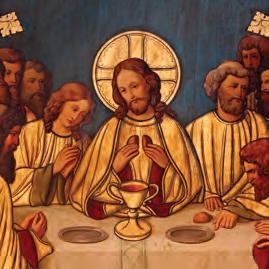






This is a wonderful work by a brilliant and deeply reflective Catholic writer. It is at one and the same time profound andaccessible.
—Mark E. Thibodeaux,SJ
Copyright © 2022 Father S. BriceHigginbotham All rightsreserved.
Imprimatur:
Very Reverend Patrick J.Madden
DiocesanAdministrator
Diocese of Houma-Thibodaux 16 July2022
Cover art credit: javi.ruiz/iStock/Getty Images, M-image/iStockphoto/Getty Images, Miodrag Kitanovic/iStockphoto/Getty Images, YuliaBuchatskaya/iStock/GettyImages.
Back cover author photo, Mary Baird at Three OttersPhotogaphy.
Special thanks to Rockridge Press for permission to reprint from Daily Lessons from the Saints: 52 Weeks of Inspiration andEncouragement.
ISBN: 978-0-8294-5459-8
Library of Congress Control Number:2022945646
Printed in the United States ofAmerica. 22 23 24 25 26 27 28 29 30 31 Versa 10 9 8 7 6 5 4 3 21
To Mr. Todd Richard, who first inspired in me a love for the SacredPage; Fr. Cassian Elkins, OSB, who taught me how to receive spiritual nourishment from thisWord; and to Dr. Brant Pitre, PhD, who witnessed to me the integration of a deep technical knowledge of historical criticism, a profound faith, andabidingholiness.
Thisbookisaboutdiscipleship—inparticular,thepictureofdiscipleshiptheHolySpiritrevealstousintheGospelaccordingtoJohn.In thesepages,youwillfindthefourthGospel’sanswertothesequestions:WhatdoesitmeantobeadiscipleofJesus?Howcanweapply thisknowledgetoourownlives?Howdoweliveastruedisciplesof the Lord? And finally, how do we know that we’re doingso?
Therearefewmoreintimidatinggoalsthanreachingfortruediscipleship. WhoamI,youmightbeaskingyourself, tothinkIcanaspire towalksidebysidewithJesus? Oneofthepurposesofthisbookisto unpackthemanywaysScripturesuggeststhatthisisexactlywhatour aspirationsshouldbe.Thesecondpurposeofthisbookistounveil clearandpracticalwaystoapplytheNewTestamentteachingsofthe Lordsothat,justlikeHisearliestdisciples,you,too,canjourney withJesus.
Aswejourneytogether,ourroadmapissimple.First,wewill brieflystudytheetymologyandcontextofkeywordsrelatedtodiscipleship.Then,wewillquicklyturnourattentiontotheGospelof Johnandproceedstep-by-stepthroughthenarrativeintheorderthat Johnsetdownhisthoughts.Wewillseethattheseteachingscanbe summarizedinafour-partprogramofdiscipleship,thecoreofwhich isbelievingandremaininginJesus:first,someonegives witness tous
4Remaining with Jesus
aboutJesus;second,wecometo believe inHimourselves;third,we remain withJesusandHewithus;andfourth,wegiveevidenceofour discipleship by showing the love of Jesus to oneanother.
UnveilingtheScripturalessenceofthisconceptofdiscipleship beginswith,nosurprisehere, words.Thekeyistotrackdownthe subtleshadingsofthepertinentGreekandHebrewwords withintheir context becausethisishowwegettotherootoftheirintentional meanings.Thisiswheremypersonalsearchbegan,anditismyprivilege to share what I learned about discipleship withyou.
IntheOldTestament,IfoundmuchlessthanIexpected.Thereare timeswhenapersonlivesasadiscipleorstudentofsometeacheror master,butthesetimesarerelativelyfewandmuchlesscentralthan theyareintheGospels.TheOldTestamentusestheusualHebrew wordfordisciple(talmîd)onetimeandtheotherwordfordisciple(limmûd)fourtimes.1 Discipleshipdidbecomeimportantforthe JewishrabbiswhoweredescendedfromthePhariseesoftheNewTestamentperiod,butnotuntilthesecondcenturyafterChrist.There arealsootherrelationshipsintheOldTestamentofmastersanddisciplesinrelationshipwithoneanother,butnoneofthesescatteredOld TestamentprefigurationsofdiscipleshipcapturestheclearandconsistentconceptofdiscipleshipthatweseeintheGospels.Oursearchfor thebiblicalunderstandingofdiscipleship,therefore,willberootedin the NewTestament.
1.John P. Meier, A Marginal Jew: Rethinking the Historical Jesus, vol. 3, Companions and Competitors (New Haven, London: Yale University Press, 2001), 42. The single use is merely to describe an apprentice musician in 1Chronicles 25:8.
Discipleship in the Bible5
Whiletheword disciple (Gk. mathētēs)isused261timesintheNew Testament,itisfoundonlyintheGospelsandintheActsoftheApostles(thesequeltoLuke’sGospel).Itoccursexactlyzerotimesinthe remainderoftheNewTestament.Therefore,theonlysectionsofthe ScripturesinwhichtheGreekwordfordiscipleisusedinawayrelevant to our study are the Gospels and Acts.2
Thesubstantialpresenceoftheword disciple injustthesebooks suggeststhattheconceptofdiscipleshipisofgreatimportancefor Jesusandtheevangelists,andthatithassomeparticularconnection withthehistoricalministryofJesusthat,ofcourse,overflowsintothe ministryoftheChurch.Butwhatexactlywasmeantbythisword disciple and,moreimportant,thisconceptofdiscipleship?Thewordsof Bible scholar Father John Meier arehelpful:
Aswebeginourquestforanadequatedefinition,weneedto remindourselvesthatthereligiousrhetoricofmodernChristianity oftenleadsustousetheword“disciple”quiteloosely.Thedrive toberelevantpushespulpitoratoryandtheologicalmusingsto employtheword“disciple”inasmanymeaningsorinasbroada senseaspossible...Perhapssomemightprefertostickwiththeir intuition.Theywouldsimplytakeforgrantedthat,sincethebasic meaningof mathētēs is“learner”or“student,”adiscipleofJesuswas anyonewholistenedtoandlearnedtheteachingsofrabbiJesusas oneofhisstudents.ButtheGospels’pictureofJesus’disciplesis not so simple.3
2.While it stands to reason that the New Testament concept of discipleship is informed by its Old Testament antecedents mentioned above, the vast usage of the concept and its circumscription into the single term µαθητής (mathētēs, “disciple”) within the Jesus movement indicates the centrality of the concept of discipleship for Jesus and His followers beyond the emphasis given to it in its Old Testament antecedents.
3. A Marginal Jew, 3:49–50.
FatherMeierdeducesthatthe absoluteabsence oftheterm disciple in thelettersofPaul,theCatholicEpistles,andRevelation,alongwith thefactthatitdoesnotfigureprominentlyinthewritingsofother earlyChristians,indicatethatthetermwashistoricallyusedbyJesus andHisdisciples.Inotherwords,theword disciple wasactuallyused inthetimeofJesusandnotjustwrittenintotheGospelsbecauseit was being used in the early church.4
Eachtimetheword disciple isusedintheGospelaccordingto John,itisclearthatinthetimeofJesus,thewiderpublicwasfamiliar withtheword.Theword disciple wasusedtodescribeapersonwith someassociationtoapublicfigure.Forexample,whenJesuswason trialbeforeAnnasthehighpriestandPeterdeniedJesus,multiple servantsaswellasAnnashimselfmakereferencetodisciplesofJesus (John18:16,19,25).Thismeanseitherthattheconceptofdiscipleshipwasacommonenoughphenomenoninfirst-centuryPalestine thatitwaspartofthenormallanguageofthepeople,orthatJesuswas particularly associated with disciples.5
Thenextquestiontoansweris:WhyfocusonJohn?Theanswer issimple.OfthefourGospelaccounts,Johnusestheword disciple morethananyother:atotalofseventy-eighttimes.Discipleshipplays amoreprominentroleintheGospelaccordingtoJohnthaninany other book of theBible.
IntheGospelaccordingtoJohn,wefindtwokeywordsforJohn’s portraitofdiscipleship: believe and remain.Hemakesthisespecially
4.Meier, A Marginal Jew, 3:41.
5.See Meier, A Marginal Jew, 3:40–73. The Gospel according to John thrice mentions disciples of John the Baptist (John 1:35, 37; 3:25), and the Pharisees once refer to themselves as disciples of Moses (John 9:28). The Pharisees also had disciples, but these “disciples of the Pharisees” are mentioned in only two parallel passages, Mark 2:18 and Luke 5:33. Disciples of the Pharisees are not mentioned inJohn.
Discipleship in the Bible7
clearinJohn8:31,where“JesussaidtotheJewswhohadbelieved [pisteúō]inhim,‘Ifyouremain[ménō]inmyword,youaretrulymy disciples[mathētēs].’”6 AtruedisciplechoosestobelieveinJesus,and thisbeliefremainsorabidesthrougheverystruggle,alwaysprogressingtowardadeeperfaith.Thisdoesn’tmeanthatthetruedisciple neverstrugglesorneverstumblesbutthathechoosesJesusagainand again.7
BiblescholarCraigS.Keenerwrites,“FrequentlyJohnmentions thatmany‘believed’inJesus(2:23;7:31;10:42;11:45;12:11,42), butatleastinmanyofthesecasesthisfaithprovesinadequatetopersevereforsalvation.”8 Themaintakeawayhereisthattruediscipleship requiresbothbelievingandremaininginJesus.It’snotenoughfor youandmetojustbelievethatJesusexistsorthatHeworksmiracles. No;thedeepjoypromisedbyJesusisforthosediscipleswhocome intorelationshipwithJesusandstayinrelationshipwithHim—even throughstruggles,persecutions,andtherepentancethatisnecessary when we fallshort.
TheGospelpresentsrealstoriesofrealpeoplewhohadreal encounterswithJesusChristandsubsequentlybecameHisdisciples. Aswewalkthroughthestoriesofthoseearlydiscipleswhobelieved andremained,wewillencounterandexplorewhatJohnpresentsas criteriaforbeingadiscipleofJesus—namelybelieving(pisteúō)and remaining(ménō).Theseexperiencesofthefirstdisciplesshowus how we ourselves can live that kind ofdiscipleship.
6.RSV-2CE translation adjusted by the author, based upon the Greek text (NA28).
7.Michael J. Wilkins, “Disciples and Discipleship,” in Dictionary of Jesus and the Gospels, 2nd ed, ed. Joel B. Green, Jeannine K. Brown, and Nicholas Perrin (Downers Grove, IL: IVP Academic, 2013),211.
8.Craig S. Keener, The Gospel of John: A Commentary, vol. 1 (Grand Rapids, MI: Baker Academic, 2003), 746. See also pp. 276–79.
8Remaining with
Anchoredbybelievingandremaining,therearefourbasicmovements bywhichapersonbecomesandlivesasadiscipleofJesus.First,the disciplebeginstobelievethroughsomeformofwitness.Theforms ofwitnessincludebutarenotlimitedtoapropheticsign,theword ofanother,theScriptures,andinspirationfromtheFather.Shethen encountersJesusinapersonalway,eitherphysically,asduringJesus’ earthlylife,orafterHisAscensionintoheaven,throughtheSpirit atworkintheworld.Thispersonalencountergroundsandsolidifiesthedisciple’sbelief.Then,empoweredbyJesus,thenewdisciple mustchoosetoremainwithHim,particularlythroughthesuffering whichinevitablycomes(John15:5;9:34–38;16:33).Thisisamutual remainingthatchangesthefocusofthedisciple’slife.Nowherfirst priorityisherrelationshipwithJesus(John6:56–57;15:5).Thedisciplelivesandactsnotfromherownpowerbutfromthepowerof Jesus,withtheFatherandtheSpirit(John14:1–3,16–17;15).Her truediscipleshipbearsthefruitofpracticallove,whichhastheeffect ofbuildinguptheChurchandwitnessingtootherpotentialbelievers(John8:31;13:34–35;15:16–17).Saidanotherway,thebasic dynamicofeachperson’sgrowthindiscipleshipgoessomethinglike this,withbelievingandremaininginJesusatthecoreofourjourney:
1.I begin to believe because someone gives witness to me. In other words, someone tells me who Jesus is and how a relationship with Him makes a practical difference in his ownlife.
2.I have a personal encounter with Jesus, which solidifies that belief. I literally meet Jesus. As He walked upon the earth, people met Him physically. Now, we meet Him through the Holy Spirit whom He has sent. We encounter Him as we pray, in our neighbor, as we read the Scriptures, and especially in the Eucharist.
3.I choose to remain with Jesus, even through trials, temptations, and sufferings. I don’t stop praying, reading Scripture, or receiving the sacraments, even when I encounter doubt, discouragement, or persecutions from others. If I fall into mortal sin, I go immediately to Reconciliation. I grow closer to the Father, Son, and Holy Spirit, sometimes in ways I can perceive and sometimes in ways that I can’t perceive in themoment.
4.Empowered by the Holy Spirit, my believing and remaining bear fruit in practical love that builds up the Church and witnesses to other potential believers. I use the gifts that God has given me to help my fellow disciples live in closer and closer relationship with Jesus, and I share my faith with those who are not disciples. I help the poor. I tell others who Jesus is and how a relationship with Him makes a practical difference in my ownlife.
Allfourofthesemovementsareessentialtodiscipleshipbutbelieving andremainingarethetwohingeactionsthatmaketherestpossible. Infact,wewillcometolearnthatremainingisthenaturalconsequence and perfection of a person’s progress in faith/believing.
TheGospelaccordingtoJohn(andtheentireNewTestament)was handeddowntousinGreek.TheOldTestamentwaswrittenmostly inHebrew,withsomeGreekandalittleAramaic.ReadingourBibles inEnglish(alanguagethatdidn’tevenexistatthetimeoftheNew Testament)twothousandyearsafterthebiblicaltextswerewritten meansthatsomethingsareliterallylostintranslation.Aswediscover whattheHolySpiritinspiredSt.Johntowriteconcerningdiscipleship,itisimportantforustopayattentiontotheactualwords St.Johnselected.Specificwordsaren’ttheonlywayanauthor Discipleship
communicatesmeaning—healsousesactionsandcontext—butthe wordsthemselvesareanimportantindicationoftheauthor’s intention.
TheGreekverbfor“believe”is pisteúō.However, pisteúō canalso mean“trust”inthesenseof“toentrustoneselftoanentityincompleteconfidence”or“entrust”asin“Ientrustthispreciousfamily heirloomtoyousothatyoumightkeepitsafe.”Itcanalsomean“be confidentabout”or“think/considerpossible.”Thenominal(noun) formofthiswordis pístis,commonlytranslatedintoEnglishas“faith” or“belief,”butsometimesmeaning“trust,confidence,apledge,ora commitment.”9 AswereadourEnglishBibles,itiseasytomisssome ofthenuanceoftheBible’smeaningbecauseusingdifferentEnglish wordsunintentionallyhidesthefactthattheseconceptsareexpressed by the same word in Greek and are therefore very closelyconnected.
For“remain,”wehaveasimilarproblem.TheGreekverb ménō canbetranslated“remain,stay,abide,live,persist,”andthelike.The nounformis mónē,whichinJohnmeans“astateofremaininginan area,staying,tarrying”or“aplacewhereonestays,dwelling(-place), room,abode.”10 Withthesevariationsinlanguage,eventhemost attentivereaderoftheGospelinEnglishwillmisstheconnection betweenJohn1:38,whereAndrewandtheotherdiscipleaskJesus, “Wheredoyoulive[ménō]?”andJohn14:2,whereJesustellsus,“In myFather’shousearemanyrooms[mónē];ifitwerenotso,wouldI have told you that I go to prepare a place foryou?”
Thefactisthatthesearedifferentformsofthesameword.Atthe beginningoftheGospel,Jesus’firstdisciplesexpresstheirsprouting desiretolive/remainwithJesusand,neartheendoftheGospel,Jesus 9.See F.W. Danker, ed., AGreek-EnglishLexicon of the New Testament and Other Early Christian Literature, 3rd ed. (Chicago, IL: University of Chicago Press, 2000), 816–20, henceforth cited as BDAG. 10.See BDAG, 630–31, 658.
revealsthatHehashadaplacepreparedthiswholetimewhereHe wantsHisdisciplestolive/remainwithHim.Thisisthepointofthe wholeGospel,frombeginningtoend:Jesuscomestomaketruediscipleswho,havingbelievedinHim,remainintheHeavenlycommunionthatHeshareswiththeFatherandtheHolySpirit.Itwasonly byreadingJohn14intheoriginalGreekthatImyselfwasabletosee this connection for the firsttime.
Thisbookissetuptohelpusliveourowndiscipleship.Anddiscipleshiponlyhappensinrelationship,firstwithJesus,thenalmostalways withfellowChristianshereonearth.Everychapterendswith(1)a prayertobringtoJesuswhatwe’velearnedandaskHimforthehelp weneedtoliveit;and(2)questionstodiscussinsmall-groupBible study.Youcanmeetonceperweek.Youcanmeetoncepermonth. Youcanmeetinpersonorvirtually.Howeveryoudoit,thebestway tolivewhatyouarelearningistocometogetherwithfellowdisciplessothatyoucanhelponeanotherinyourjourneys.Ifitisn’tpossibleforyoutogettogetherwithothers,atleasttakesometimeto thinkaboutthequestionsonyourown—maybethiscanbepartof yourprayertime.Pleasedospendtimewritingdownatleastsome ofyouranswers.There’ssomethingaboutwritingthatmakesthings stickinourmindsandhearts.Don’tskiptheprayer;actuallyprayit. Anddon’tskipthequestions;letJesusspeaktoyourheartthroughthe wordsofHisGospel.Finally,ifyou’reupforleadingasmallgroupbut havequestionsabouthowtodoit,turntopages87–88forsometips.
Nowthatweknowthebasics,let’sdiveintothefirstencounter betweenJesusandHisdisciples.Butfirst,Iinviteyoutotakea momenttopray.IfyoudecidetopraytheseprayerswithyourBible study group, change I to we, me to us, and my to our:
12Remaining with Jesus
Letuspray: LordJesus,YouhavecalledmetobeYourdiscipleand havegivenmemanyexamplestoimitate.Aidedbytheprayersofthe holymenandwomenwhomIwillmeetinthepagesofthisbook,give methegiftoffaith,thatImightbelieveinYou,andthegiftofcourage, thatImightremainwithYou.MayIencounterYoutoday.Teachme, dear Jesus, how to love my neighbor as myself for love of You.Amen.
Answersorpossibleanswersarefoundonpages89–90.But ponderthequestionsforyourselforsharewithyourBiblestudy group before giving the answers alook.
• Where do you find yourself as we begin our journey together? What do you want out of this Bible study? What do you think when you hear the word disciple rightnow?
• In which books of the New Testament is the word disciple used? In which book does the word disciple appear most frequently? According to this chapter, what does this tell us about the use of the word disciple in the time ofJesus?
ReadJohn8:31;thendiscussthesequestionsinyourgroupor ponder them on your own.
• According to John 8:31, what are the two central things that a true disciple does? What do you think when you hear the word believe right now? The word remain?
• According topages 8–9above, what are the four basic dynamics of a person’s growth in discipleship? How does this describe your experience ofdiscipleship?
• What are you most excited about as we begin to learn about discipleship together? How can the people in your Bible study (or your other friends) pray foryou?
FatherS.BriceHigginbotham isaCatholicpriestfortheDioceseof Houma-ThibodauxinLouisianawhoiscurrentlypursuingaLicentiateinSacredScriptureatthePontificalBiblicalInstituteinRome, Italy.OrdainedtothepriesthoodofJesusChristin2017,FatherBrice haspreviouslyservedaspastorofHolyCrossParish,Chaplainof CentralCatholicSchool, censorlibrorum,consultanttotheOfficeof ParishSupport,masterofceremonies,parochialvicaratChristthe RedeemerParishandtheCathedralofSt.FrancisdeSales,assistant vocationsdirector,statepolicechaplain,andmemberofthediocesan presbyteralcouncil.
FatherBricereceivedhismaster’sdegreeintheologicalstudiesfrom NotreDameSeminaryinNewOrleans,Louisiana.Hehaspublishedoneotherbook, DailyLessonsfromtheSaints (RockridgePress, 2020),articlesandhomiliesin Homiletic&PastoralReview,and morethansixtycatecheticalvideosincooperationwiththeDiocese ofHouma-Thibodaux’sOfficesofParishSupportandCommunications, all of which are available on YouTube andFacebook.
What does it mean to be a disciple of Jesus today?
(And why should you want to be one?)
Using the Gospel of John as his roadmap, Father Brice Higginbotham invites you to join him on an inspiring exploration of what Scripture tells us about being a disciple of Jesus and how Christian discipleship brings peace and fulfillment to your daily life. By delving into Jesus’ encounters with real people, the author provides practical guidance for healthy spiritual living based on two primary concepts: believing in Jesus and remaining with, or staying true to, Jesus in good times and bad.
In Remaining with Jesus, Father Brice introduces you to Jesus’ first disciples, offering a lens through which you can see yourself in the experiences of these men and women. Unpacking these historical encounters, he makes them as relevant to modern life as they were to Christ’s first followers. Most practically, he presents a four-part program of discipleship according to the Gospel that can uplift and transform your faith life through fellowship with Jesus.
Join Father Brice on a fulfilling journey to true discipleship.

Father S. Brice Higginbotham is a Catholic priest for the Diocese of Houma-Thibodaux in Louisiana. He is the author of Daily Lessons from the Saints and has recorded dozens of catechetical and inspirational videos available on YouTube and Facebook.
ISBN: 978-0-8294-5459-8



